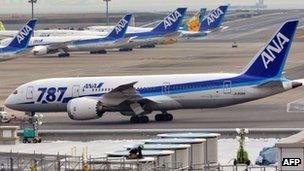Dreamliner: Boeing 'may never find battery fault cause'
- Published

The grounding of all 787s in service followed two incidents of battery malfunction
Boeing has admitted that it may never know what caused the battery malfunctions that resulted in all its 787 Dreamliner aircraft being grounded.
The admission came from Boeing's Larry Loftis, the general manager of the company's 787 division.
Replacement battery systems are now being fitted to all 50 Dreamliners that had been in operation with airlines around the world.
Boeing expects the planes to resume service in the coming weeks.
'Best practice'
On Friday, US aircraft regulators approved a revamped battery design for the aircraft, paving the way for the fleet to return to the skies.
Speaking at a media briefing in London, Mr Loftis said: "It is possible we will never know the root cause.
"It is not uncommon not to have found the single root cause. So industry best practice is to look at all the potential causes and address all of them."
The groundings of all Dreamliners in January followed two major incidents concerning the plane's two lithium-ion batteries.
Firstly, on 7 January, a battery overheated and started a fire on a Japan Airlines 787 at Boston's Logan International Airport.
Nine days later, an All Nippon Airways 787 had to make an emergency landing in Japan after a battery started to give off smoke.
'Exhaustive study'
The two lithium-ion batteries are not used when the 787 is in flight.

Mr Loftis said Boeing had addressed all "potential causes" and expected the 787 to remain popular
Instead they are operational when the plane is on the ground and its engines are not turned on, and are used to power the aircraft's brakes and lights.
Mr Loftis said Boeing had put 200,000 engineer hours into fixing the problem, with staff working round the clock.
Improved batteries are now being introduced. Mr Loftis explained that the newer batteries did not have to work so hard, and therefore operated at a cooler temperature.
In addition, the new batteries are enclosed in stainless steel boxes which have a ventilation pipe that directly goes to the outside of the plane. So Mr Loftis said that any future "rare cases" of battery failure would be "100% contained", with any smoke immediately leaving the plane.
He added: "We did an exhaustive study of potential causes, and addressed all of them. We do feel that with all the work we have done, we have tackled the potential problems."
Expanding production
A total of 300 Boeing engineers, pooled into 10 teams, have now started fitting the replacement batteries and battery systems to the 787s in service around the world, and also to those that have been built by Boeing since January.
Mr Loftis said it would take five days per plane to do the necessary work, and that it would be carried out by the order in which airlines first received the planes. For this reason, Japan's All Nippon Airlines will be the first to get its 787s fixed.
Boeing is likely to release details of how much fixing the battery problem has cost the company when it releases its latest quarterly results on Wednesday.
Mr Loftis said he did not expect the issue to have any lasting negative impact on the popularity of the Dreamliner among either airlines or passengers.
He said that Boeing had continued to make five 787s per month, and that the company was about to increase that to seven, raising output to 10 per month by the end of this year.